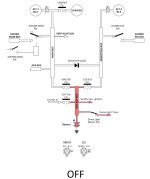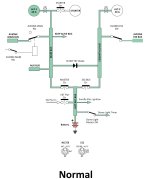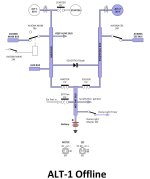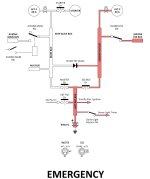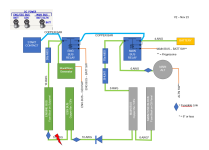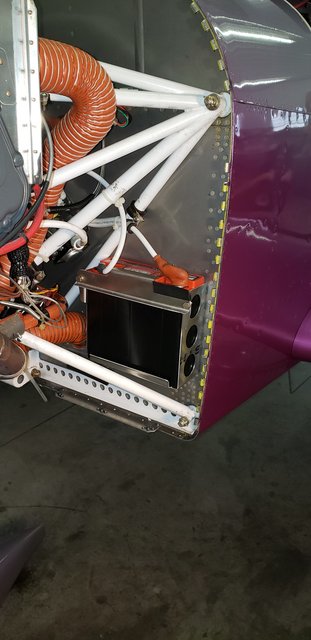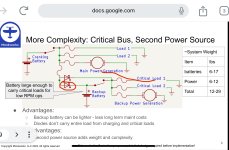Hi Brains Trust,
I am working on planning out my RV14 electrical system, with the following design goals / features:
- IFR
- Garmin G3X with IFR Nav
- SDS EFI Fuel Injection / Ignition
- Single Battery
- B&C 60amp Main alternator
- Monkworkx 30amp alternator in Backup mode.
- The system needs to be passive - no failure can require pilot action to keep the engine going
- The system needs to handle failures such that i can be IFR/IMC at night and can still have what i need to safety fly a GPS based approach.
- It needs to be bog simple and intuitive. Turn all the switches on, leave them there and go flying.
To this end, I have been working on planning out the system using KiCAD as my planning software, and an Excel based workbook with each wire/group listed as equipment to equipment / pin to pin etc. It's here i am doing load analysis etc, and will eventually do a failure analysis. It is helping me to calculated what supplies i need to order.
Attached is a basic block diagram of the system, with a few KiCAD excerpts showing the main electrical generation schematic, as well as the SDS EFI wiring schematic.
The design is based on the great work by John Bright - thank you for the inspiration!
The design has the following notes:
The normal use scenario is as follows:
I know asking people to review my electrical system is a big ask - i am totally open to criticism and will happily take on all comments. I have an open mind as this is my first attempt at something like this. My aim here is to flesh this all out and try and think of as many gotchas now before i even get close to running wires.
Thanks in advance to the brains trust for your help and assistance. If anyone wants any more detail etc just ask and i will make a follow up post.
I am working on planning out my RV14 electrical system, with the following design goals / features:
- IFR
- Garmin G3X with IFR Nav
- SDS EFI Fuel Injection / Ignition
- Single Battery
- B&C 60amp Main alternator
- Monkworkx 30amp alternator in Backup mode.
- The system needs to be passive - no failure can require pilot action to keep the engine going
- The system needs to handle failures such that i can be IFR/IMC at night and can still have what i need to safety fly a GPS based approach.
- It needs to be bog simple and intuitive. Turn all the switches on, leave them there and go flying.
To this end, I have been working on planning out the system using KiCAD as my planning software, and an Excel based workbook with each wire/group listed as equipment to equipment / pin to pin etc. It's here i am doing load analysis etc, and will eventually do a failure analysis. It is helping me to calculated what supplies i need to order.
Attached is a basic block diagram of the system, with a few KiCAD excerpts showing the main electrical generation schematic, as well as the SDS EFI wiring schematic.
The design is based on the great work by John Bright - thank you for the inspiration!
The design has the following notes:
- - A single dedicated engine bus fuse block located behind the panel feeds the engine electronics. This will live close by the SDS ECU / Relay box, and will be visible for pre-flight checks of the fuses. I will likely used a Bussman or Bluesea fuse block - i am happy that these are robust enough not to be a SPOF. (plus the injectors only have a single source of power anyway).
- - This bus is fed by the battery through a relay, or fed from the monkworkx generator, or via a diode from the main bus (and main alternator). (3 sources of power).
- - The relay is needed between the battery and the engine bus because i believe the Monkworkx will have a parasitic drain otherwise.
- - An Essential bus, is fed from the engine bus at one end, and the main but at the other end. This gives power to the basic IFR instruments (GAD27 - which feeds keep alive power to PFD, GEA24 etc, as well as G5, NAV, 1 x com, cockpit lights, Autopilot etc). This is a CB fed bus located where the RV14 circuit breaker panel is.
- - On the main bus / main fuse block is everything else in the aircraft. The main fuse block will only be installed if i run out of CB's on the main bus. This is also located on the RV14 Circuit Breaker panel area.
- - The idea is that any of the 3 DC source switches can be on in flight, and i will have the engine bus and minimum IFR instruments.
- - In normal ops, all 3 DC source switches are on at all times.
The normal use scenario is as follows:
- - Normal ops will see the ENG/ESS BUS - BATT and GEN switches turned on. This will power the engine ECU's, and basic instruments from the battery. One fuel pump is turned on. Both ignitions are turned on and engine is started.
- - The monkworkx should then take over supply of the eng/ess bus and show it is working. The ENG/ESS BUS - BATT switch could be turned off as a test to check the Monkworkx can handle all engine/ess loads.
- - The MAIN BUS BATT/ALTN switch is then turned on and the main alternator takes over, and the monkworks goes to sleep, checking the main alternator is working.
- - Runups would include swapping fuel pumps (and leaving them swaped to even out the duty cycles on the pumps), checking both ignitions. Swapping ECU switch to backup then back to primary. At this point no switches need be touched on the left switch panel until shutdown. Runup is simple really.
- - For normal ops, the main alternator would be feeding the main bus through a 70amp MIDI and a shunt, and through a diode the essential bus. Since the engine bus is connected to the essential bus, the main alternator would also supply the engine bus. As an additional pathway, the main alternator also supplies the engine bus through both battery contactors (aka dual feed pathways to the engine bus).
- - In a cockpit smoke scenario, or the main bus faults, the MAIN BUSS BATT/ALTN switch is turned off. This kills power to the main bus and everything except the essential items. I can then pull CB's on the essential bus, as required, if the smoke persists.
- - If the main alternator fails, the monkworkx passively takes over as the voltage drops to battery volts (with a CAS message etc).
- - If the battery catches fire, i can turn off both battery switches and the monkworks powers the engine and essential items.
- - If the essential bus faults - then i kill the main battery switch to turn off the main buss and it's supply to the essential bus. Do i need to place a relay inline between the engine bus and the essential bus, such that power flows through the normally closed contacts, and a "shed" switch to turn off this bus? Or just pull the 5-6 breakers along the bottom row? This will be fed with a fuseable link from the engine bus to protect it's feed wire, and from the main bus through a diode the wire will be short. But nothing really protects the essential bus itself from a short? (this will be CB's and a copper bar).
- - If the engine bus faults - will then i have an issue. But i think this is a low risk event. I will use a sealed automotive fuse block. What could really go wrong with this?
- - For those who have installed the Monkworkx, do i need the 30amp MIDI on the feed line from this generator? Or is it fuse protected internally?
- - There are probably many failure points i have not considered!
- - I was thinking for the 2 battery 'contactors' that i would use some Gigavac relays instead. I don't really see why i need the old tin can versions? Why not just a relay?
I know asking people to review my electrical system is a big ask - i am totally open to criticism and will happily take on all comments. I have an open mind as this is my first attempt at something like this. My aim here is to flesh this all out and try and think of as many gotchas now before i even get close to running wires.
Thanks in advance to the brains trust for your help and assistance. If anyone wants any more detail etc just ask and i will make a follow up post.
Attachments
Last edited:



